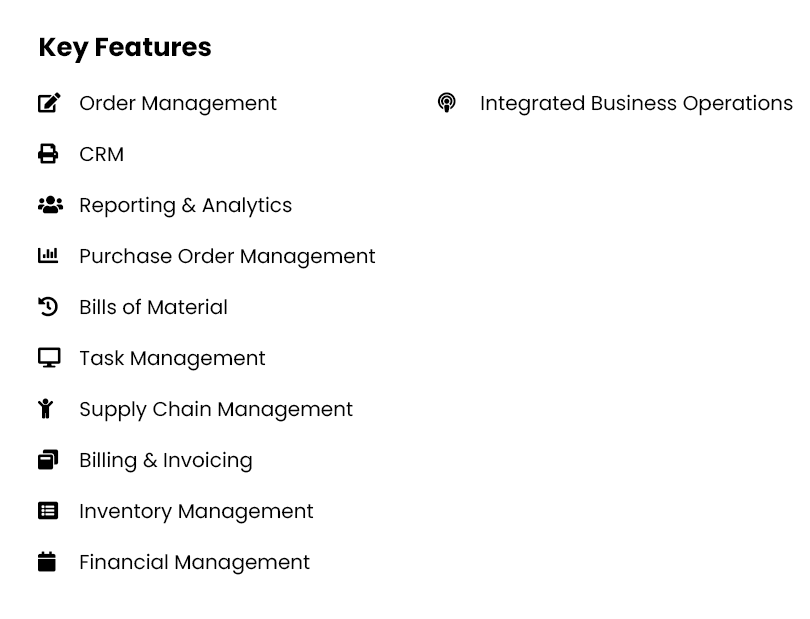Products > ERP > ERP Systems
ERP Systems
Manage resources, streamline operations, and make informed business decisions, driving overall business by integrating all your business processes into a single platform, improving efficiency and data accuracy.
Oversee and coordinate the entire lifecycle of customer orders, from entry and processing to fulfillment and delivery for enhanced:
Visibility: Provide real-time visibility into order status and progress.
Workflow Automation: Automate order processing tasks to improve efficiency and reduce manual errors.
Customer Experience: Enhance satisfaction by ensuring seamless order handling and timely delivery.
Order Management
Use software and strategies to manage interactions and relationships with customers for:
Data Centralization: Store customer information in a centralized database.
Sales Management: Track leads, opportunities, and sales activities.
Customer Service: Improve customer support and issue resolution.
CRM
Collect, analyze, and interpret data for enhanced:
Data-driven Decisions: Provide actionable insights into business performance, trends, and opportunities.
Performance Monitoring: Track key metrics and KPIs to evaluate progress towards goals.
Forecasting: Predict future outcomes and trends based on historical data analysis.
Reporting & Analytics
Purchase Order Management
Create, approve, track, and manage purchase orders for improved:
Procurement Control: Control and track procurement activities to ensure compliance with budget and procurement policies.
Inventory Management: Update inventory levels based on incoming orders and deliveries.
Supplier Relations: Manage relationships with suppliers through timely order processing and fulfillment.
Itemize the components, parts, and raw materials needed to manufacture or assemble a product in comprehensive lists to provide:
Manufacturing Guidance: Provide detailed instructions for assembling products, specifying quantities and materials needed.
Inventory Management: Facilitate inventory tracking by listing components and materials used in production.
Cost Estimation: Help in estimating the cost of manufacturing by listing all required materials and components.
Bills of Material
Organize, assign and track tasks and activities for the purpose of:
Productivity: Improve efficiency by prioritizing and managing tasks effectively within teams or projects.
Collaboration: Facilitate teamwork and communication by assigning tasks and monitoring progress.
Goal Achievement: Ensure alignment of tasks with strategic objectives and timelines for successful project completion.
Task Management
Oversee the end-to-end process of sourcing, procurement, production, and distribution of goods or services for enhanced:
Efficiency: Optimize processes and workflows to reduce costs and improve operational efficiency.
Inventory Management: Manage inventory levels and logistics to meet demand and minimize stockouts.
Collaboration: Coordinate activities and information flow among suppliers, manufacturers, and distributors to enhance supply chain visibility and responsiveness.
Supply Chain Management
Generate, manage, and send bills or invoices to customers for products or services using technology-based systems for:
Revenue Collection: Facilitate the collection of payments from customers for goods or services provided.
Financial Management: Track and record transactions, ensuring accurate financial reporting.
Customer Relationship: Provide transparency and clarity in financial transactions, enhancing customer trust.
Billing & Invoicing
Oversee and control the flow of goods, products, or materials to benefit:
Optimization: Balance supply and demand to minimize stockouts and overstock.
Cost Efficiency: Reduce carrying costs and optimizing inventory levels.
Order Fulfillment: Ensure timely order processing and delivery.
Inventory Management
Oversee and optimize financial resources, budgets, investments, and expenses to aid:
Budgeting: Plan and allocate financial resources effectively.
Risk Management: Identify and mitigate financial risks.
Performance Analysis: Evaluate financial performance and make informed decisions.
Financial Management
Integrated Business Operations
Align and connect different functional areas or departments through shared systems or platforms for:
Efficiency: Improve collaboration and communication across departments.
Data Consistency: Ensure consistency and accuracy of information across systems.
Process Streamlining: Automate workflows to optimize overall business performance.














